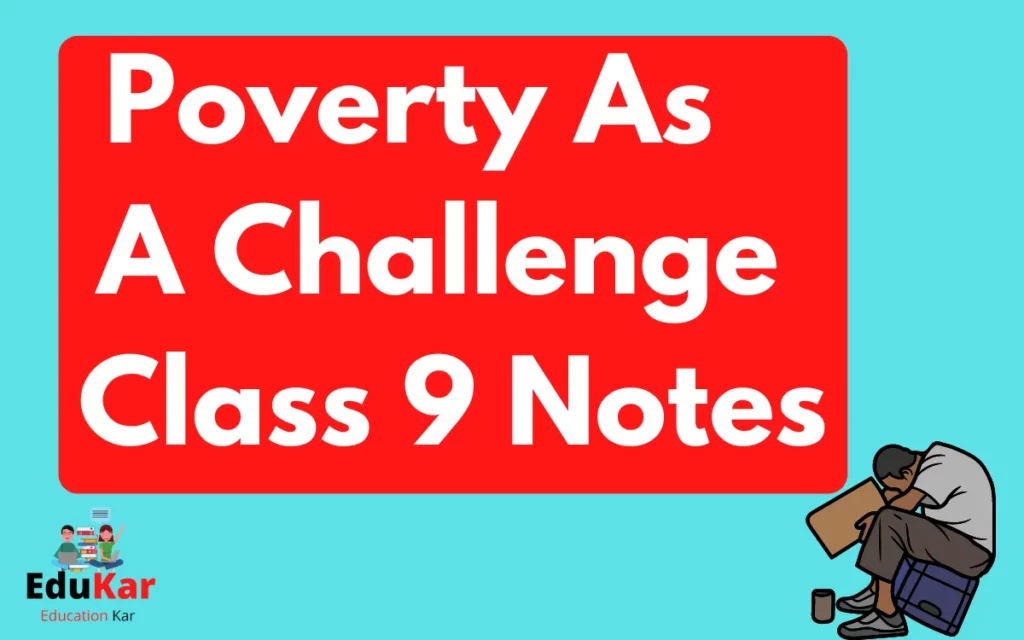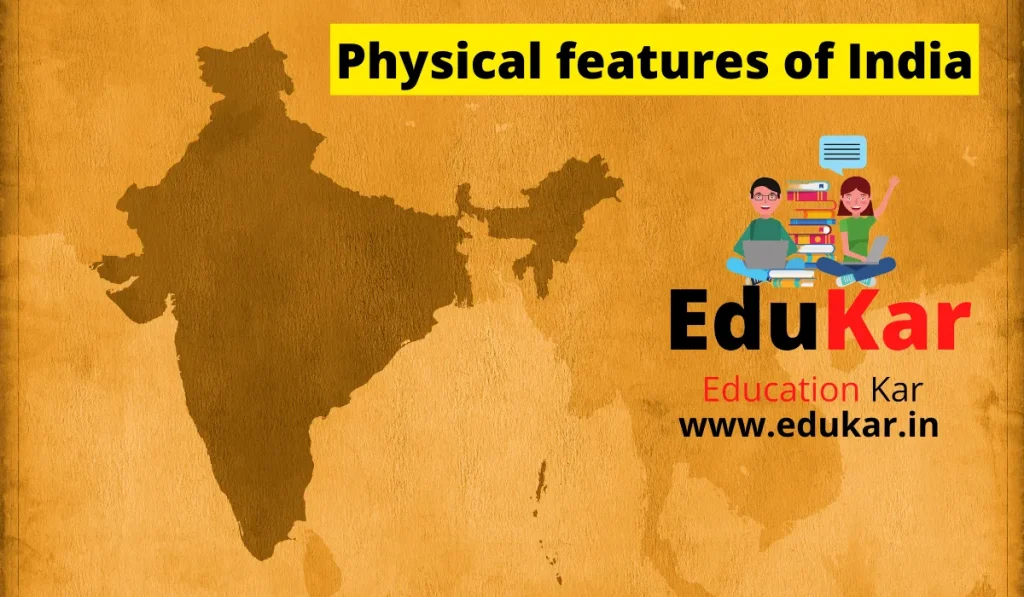Contents

Introduction
Everywhere we look in daily life, we witness poverty. They can be villagers’ landless labourers, city dwellers living in cramped jhuggis, daily wage employees, or children working in dhabas. In India, every fourth person is poor, according to data.
Two Typical Cases of Poverty
Hunger and lack of adequate housing, access to clean water and sanitary facilities, and regular employment at a minimum respectable level are all signs of poverty. One of India’s main problems since becoming independent is poverty. Only when the world’s poorest people are liberated from human suffering then India genuinely be independent.
Numerous indicators are used by social scientists to study poverty. Typically, the indicators are used to compare levels of consumption and income. The absence of access to healthcare, employment opportunities, clean drinking water, sanitation, etc., as well as the level of illiteracy and lack of overall resistance caused by malnutrition are increasingly considered social markers of poverty.
Poverty Analysis by Social Scientists
Social scientists examine poverty from a variety of angles in addition to income and expenditure levels.
These features are
- Low literacy level
- Malnutrition resulting in weak disease resistance
- Healthcare not readily available
- Lack of employment options
- Lack of access to sanitary facilities, clean water, etc.
Indicators for Poverty
Social exclusion and vulnerability are the two markers of poverty that are most frequently utilised.
Poverty Line
The poverty line is a technique used to quantify poverty based on levels of consumption or income. The poverty line varies by location and time. In India, the basic requirements for food, clothing, footwear, fuel and light, as well as for medical and educational care, are used to calculate the poverty line. The prices of these physical quantities in rupees are multiplied. In India, the ideal calorie requirement is used to determine poverty levels. In India, it is generally considered that each person needs 2400 calories per day in rural areas and 2100 calories per day in urban areas. Based on these figures, the poverty threshold for an individual was set at Rs. 816 per month in rural areas & Rs. 1000 for urban areas. The National Sample Survey Organization periodically (often every five years) estimates the poverty line through sample surveys (NSSO).
Poverty Estimates
The poverty rate in India has significantly decreased, going from roughly 45% in 1993–1994 to 37.2% in 2004–2005. In 2011–12, the percentage of persons living below the poverty line decreased even more, reaching roughly 22%.
Vulnerable Groups
Scheduled Tribe & Scheduled Caste social groupings are at risk for poverty. Similar to this, the most vulnerable economic groupings are the homes of rural agricultural labourers and urban casual labourers. According to a recent study, all three groups—scheduled castes, rural agricultural labourers, and households with casual workers—saw a decrease in poverty in the 1990s, with the exception of scheduled tribes.
Inter-State Disparities
In India, not every state has the same percentage of the population living in poverty. The two poorest states are still Bihar & Odisha, with poverty rates of 33.7 & 32.6 percent, respectively. Odisha, Madhya Pradesh, Bihar, & Uttar Pradesh have high rates of urban poverty. Poverty decreased in Kerala, Maharashtra, Andhra Pradesh, Tamil Nadu, Gujarat, and West Bengal. Historically, Punjab and Haryana have been successful in decreasing poverty thanks to rapid agricultural growth. Kerala has placed more emphasis on developing its human resources. Land reform initiatives have contributed to a decrease in poverty in West Bengal. Public distribution of food grains is to blame for the progress in Andhra Pradesh & Tamil Nadu.
Global Poverty Scenario
As a result of rapid economic expansion and significant investments in human resource development, poverty levels in China and Southeast Asian nations significantly decreased. Poverty decreased in Sub-Saharan Africa from 51% in 2005 to 41% in 2015. The percentage of people living in poverty in Latin America has decreased from 10% in 2005 to 4% in 2015.
Causes of Poverty
The extensive poverty in India is caused by a variety of factors.
1. India’s economy under British rule experienced little development. The colonial government’s new policies destroyed traditional handicrafts and stifled the growth of industries. I enjoy fabrics. The growth rate of per capita income was extremely low due to sluggish growth and a rise in population. There are many work prospects in the agriculture sector thanks to the Green Revolution and the widespread use of irrigation. These, however, were insufficient to accommodate all job hopefuls.
2. Vast income disparities have been another aspect of high poverty rates. The unequal distribution of land and other resources is one of the main causes of this. One of the main reasons for poverty in India has been a lack of land resources, yet effective policy execution may have improved the lives of millions of rural poor people.
3. To purchase agricultural inputs like seeds, fertiliser, insecticides, and other items, small farmers needed money. Due to their poverty, they were forced to borrow money and were unable to pay it back.
Anti-Poverty Measures
There are two aspects to the present anti-poverty program.
1 Encouragement of economic expansion
2 Specific anti-poverty initiatives
India’s economy has grown at one of the world’s quickest rates since the 1980s. Economic expansion and the eradication of poverty are closely related. Some of the programs designed to directly or indirectly combat poverty include:
The Mahatma Gandhi National Rural Employment Guarantee Act of 2005 is one such law. In order to assure the security of every household’s source of income in rural areas, it sought to provide 100 days of wage work. In order to address the root causes of drought, deforestation, and soil erosion, it also focused on sustainable development. Women have been given preference for one-third of the proposed positions.
2. The Prime Minister Rozgar Yojana (PMRY) was launched in 1993. The program’s primary goal is to provide educated unemployed adolescents in rural and small-town regions with chances for self-employment.
3. The Rural Employment Generation Program (REGP) was introduced in 1995. The program’s goal is to develop independent work opportunities in rural and small towns.
4. Swarnajayanti Gram Swarozgar Yojana (SGSY) was introduced in 1999. The program’s goal is to lift the helped impoverished families beyond the poverty line by forming self-help groups and using a combination of government assistance and bank financing.
5. The Pradhan Mantri Gramodaya Yojana (PMGY) was introduced in 2000. Under this scheme, states receive increased central aid for fundamental services including primary health care, primary education, rural shelter, rural drinking water and rural electrification.
The Challenges Ahead
Even though poverty has decreased in India, it is still the country’s greatest challenge. In the ten to fifteen years to come, poverty reduction is anticipated to advance more. This can be accomplished through increasing economic growth, placing more emphasis on providing all children with a free, basic education, controlling population increase, and empowering women and those in economically disadvantaged groups more.


![Digital Documentation Class 9 [Questions Answers & MCQ] Digital Documentation Class 9](https://edukar.in/wp-content/uploads/2022/08/Digital-Documentation-Class-9-1024x597.webp)

![No Men Are Foreign Class 9 Question Answer [NCERT] No Men Are Foreign Class 9 Question Answer](https://edukar.in/wp-content/uploads/2023/01/No-Men-Are-Foreign-Class-9-Question-Answer-1024x640.webp)

![Packing Class 9 Questions and Answers [Class 9 English Beehive Chapter 7 ] Packing Class 9 Questions and Answers [Class 9 English Beehive Chapter 7 ]](https://edukar.in/wp-content/uploads/2023/01/Packing-Class-9-Questions-and-Answers-1024x640.webp)
![Natural Vegetation and Wildlife Class 9 Questions Answers [Class 9 Geography Chapter 5] Natural Vegetation and Wildlife Questions Answers](https://edukar.in/wp-content/uploads/2023/01/Natural-Vegetation-and-Wildlife-Questions-Answers--1024x640.webp)

![A House Is Not A Home Question Answer [Class 9 English Moments Chapter 8] A House Is Not A Home Question Answer](https://edukar.in/wp-content/uploads/2023/01/A-House-Is-Not-A-Home-Question-Answer-1024x640.webp)


![Weathering The Storm In Ersama Summary [CBSE Class 9] by Harsh Mander Weathering The Storm In Ersama Summary](https://edukar.in/wp-content/uploads/2022/10/Weathering-The-Storm-In-Ersama-Summary-1024x536.webp)
![What is Sublimation with Examples? [Class 9,10th,11th] What is Sublimation with Examples](https://edukar.in/wp-content/uploads/2023/03/What-is-Sublimation-with-Examples.webp)
![No Men Are Foreign Summary [CBSE Class 9] By James Falconer Kirkup No Men Are Foreign Summary](https://edukar.in/wp-content/uploads/2022/10/No-Men-Are-Foreign-Summary--1024x536.webp)
![Weathering The Storm in Ersama Question Answer [Class 9 English NCERT Solutions] Weathering The Storm in Ersama Question Answer [Class 9 English NCERT Solutions]](https://edukar.in/wp-content/uploads/2023/01/Weathering-The-Storm-in-Ersama-Question-Answer-1024x640.webp)
